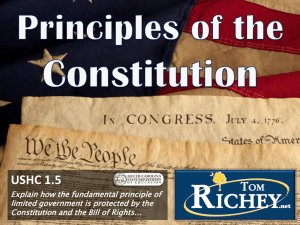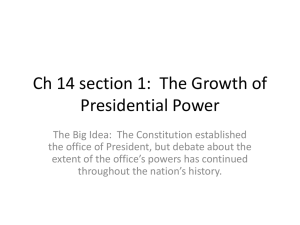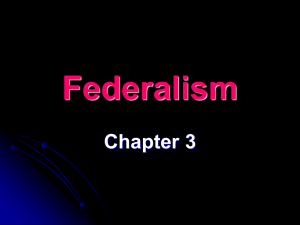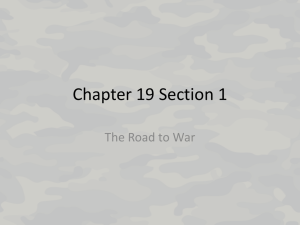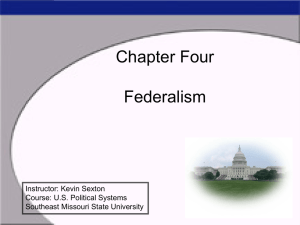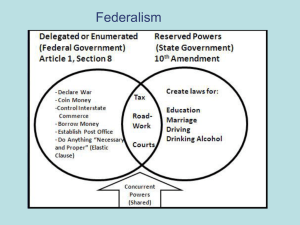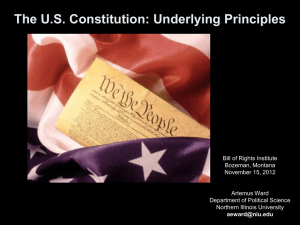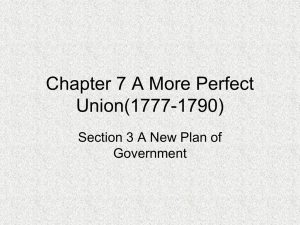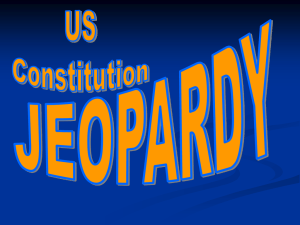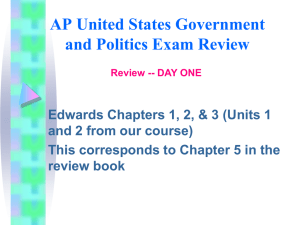Defining Federalism
advertisement
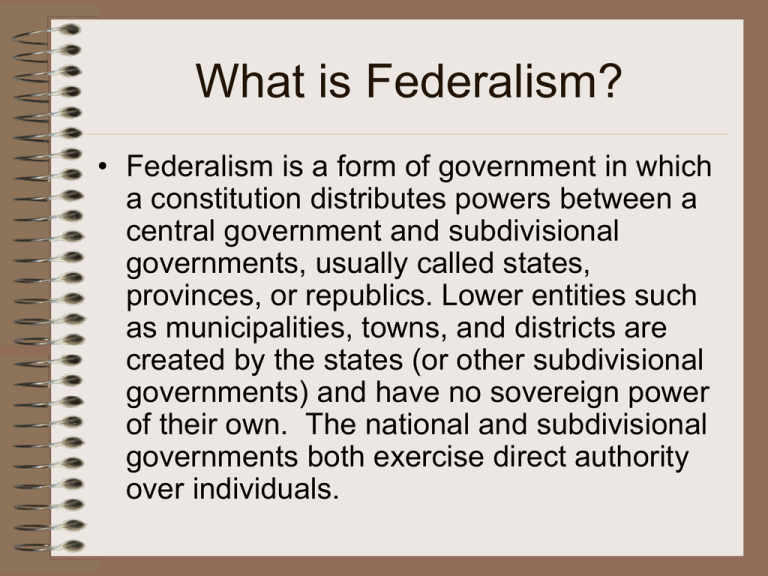
What is Federalism? • Federalism is a form of government in which a constitution distributes powers between a central government and subdivisional governments, usually called states, provinces, or republics. Lower entities such as municipalities, towns, and districts are created by the states (or other subdivisional governments) and have no sovereign power of their own. The national and subdivisional governments both exercise direct authority over individuals. Alternatives to Federalism • Unitary Systems (centralized powers) • Confederate Systems (an alliance of sovereign nations) • Autocracy (dictatorship) • Oligarchy (rule by a small group) • Constitutional monarchy Government under the Articles of Confederation, 1781-1788 • The confederation was a union of states in which the central government received power from the states and had no direct authority over the people. • In practice, it was unable to force states to pay the taxes they owed and remained a weak system of government. Government under U.S. Constitution (Federation): 1789 - The Flow of Power in Three Systems of Government Advantages of Federalism • Federalism checks the growth of tyranny • Federalism allows unity without uniformity • Federalism encourages experimentation • Federalism keeps government closer to the people – Training for national officials – More arenas for public participation Federal Systems Advantages Disadvantages • Permits diversity and diffusion of power • Local governments can handle local problems better • More access points for political participation • Protects individual rights against concentrated government power • Fosters experimentation and innovation • Suits a large country with a diverse population • Makes national unity difficult to achieve and maintain • State governments may resist national policies • May permit economic inequality and racial discrimination • Law enforcement and justice are uneven • Smaller units may lack expertise and money • May promote local dominance by special interests Number of Governments in the United States 3,143 Number of Governments • In America there are close to 89,000 governments. • About half of these units are school or other special districts, and many of the remaining governments are townships and municipalities. • there are over 3,000 counties • 50 state governments and one federal government. Quick Assessment 1) The advantages of federalism are that it A) creates a unified governmental system B) encourages experimentation C) checks the growth of tyranny D) All of the above 2) In a unitary system of government, a constitution places all governmental power A) with all of the systems of government B) with the central government C) with the localities D) with the state government An Expanding Nation • A great advantage of federalism and part of the genius and flexibility of our constitutional system—has been the way in which we acquired territory and extended rights and guarantees by means of statehood, commonwealth, or territorial status, and thus grew from 13 to 50 states, plus territories. Admission of States to the Union Louisiana Purchase - 1803 Florida - 1819 Texas - 1845 Oregon - 1846 Mexican Cession - 1848 Gadsden Purchase - 1853 Alaska - 1867 Hawaii - 1898 Philippines - 1898 to1946 Puerto Rico - 1899 Guam - 1899 American Samoa - 1900 Canal Zone - 1904 to 2000 U.S. Virgin Islands - 1917 Pacific Islands Trust Territory - 1947 Admission of States to the Union Formal Constitutional Framework • The national government has only those powers delegated to it by the Constitution • The national government is supreme • The state governments have residual powers; meaning those neither assigned to the national government nor denied to the states • Some powers are specifically denied to both the national government and the state government The U. S. Constitution is the supreme law of the land. It sets forth arrangements such as checks and balances, federalism, separation of powers, rule of law, due process, and the protection of individual rights. Distribution of Power (SHARED POWERS) Set time, place, and manner of elections Ratify amendments to the U.S. Constitution Take measures for public health, safety, and morals Exert powers the Constitution does not delegate to the national government or prohibit the states from using Establish local governments Regulate commerce within a state Constitutional Division of Power Powers delegated to the National Government • Express powers stated in the Constitution – Delegated powers • Implied powers that may be inferred from the express powers – Necessary & Proper Clause • Inherent powers that allow the nation to present a united front to foreign powers Delegated National Powers • National Supremacy • War Powers • The power to tax and spend – Federal Mandates • The power to regulate interstate commerce – Commerce Clause Constitutional Division of Power Some Powers Reserved for the States • To create a republican form of government • To charter local governments • To conduct elections • To exercise all powers not delegated to the national government or denied to the states by the Constitution Constitutional Division of Power Some Concurrent Powers Shared by the National and State Governments Concurrent Powers Power to Tax National Government State Government Power To Make and Enforce Laws Power To Establish Courts Power To Police (Limited) The power to regulate interstate commerce allowed Congress to forbid discrimination like this in places of public accommodation in the 1964 Civil Rights Act. Quick Assessment 1) Congress’s ability to control the production, purchase, sale, rent, or transport of goods, services, and properties stems from A) the power to spend B) the power to tax C) the war power D) the power to regulate interstate commerce 2) The power of congress to tax and spend money is an example of A) an implied power B) an express power C) an inherent power D) All of the above 3) The four constitutional pillars include 1) the supremacy clause, 2) the war power, 3) the interstate commerce clause, and 4) the power to A) grant titles of nobility B) pass bills of attainder C) tax and spend for the general welfare D) suspend the writ of habeas corpus 4) Which statement best summarizes the role of the states in the constitutional division of power? A) States have powers not delegated to the federal government, except those denied by the Constitution. B) Within the scope of its operations, the national government is inferior to the states. C) States share all the powers delegated to the federal government. D) States have inherent powers over foreign affairs. Powers Denied to the States • Making treaties with foreign governments • Keeping troops or ships in time of peace • Authorizing private persons to prey on the shipping and commerce of other nations • Coining money, issuing bills of credit, or making anything but gold and silver coin legal tender in payment of debts • Taxing imports or exports • Taxing foreign ships • Engaging in war Quick Assessment 1) State governments have historically been strong guardians against A) segregation B) discrimination C) slavery D) none of the above 2) State governments are A) stronger than ever B) continuing to lose power C) weaker than ever D) irrelevant Police Power: In the U.S., most police power is reserved to the states. 3) State regulation of their economies have led some business interests to call for A) state compacts B) decreased federal control C) increased federal regulation D) none of the above Interstate Relations • Article IV of the Constitution attempts to resolve potential problems between states by stipulating the following: • Full faith and credit • Privileges and immunities • Extradition • Interstate compacts Political Culture: Reflected in State’s Policies Gay couples renew their vows to each other in this ceremony in San Francisco's Metropolitan Community church. States must give full faith and credit to each other’s public acts, records, and judicial proceedings; extend to each other’s citizens the privileges and immunities it gives its own; and return fugitives from justice. The Role of the Federal Courts: Umpires of Federalism • McCulloch v. Maryland (1819) • Gibbons v. Ogden (1824) • Federal Courts and the Role of States • The Great Debate: Centralists vs. Decentralists •The Decentralist Position - favor state or local action rather than national action. •The Centralist Position - favor national action over action at the state and local levels. The National Courts and Federalism The Great Debate Centralists • Abraham Lincoln, FDR • Reject the idea that the Constitution is an interstate compact • National government is the government of all the people • • • • Decentralists Antifederalists, Thomas Jefferson, Ronald Reagan Constitution is a compact among sovereign states National government should not interfere with activities of the states Devolution revolution, states’ rights Defining Constitutional Powers The Supreme Court and the Role of Congress McCulloch v. Maryland Affirmed that the power of Congress is not strictly limited to the expressed powers. Marshall held that Congress has implied powers to carry out the expressed powers. This case set the precedent for the national government to regulate a wide range of economic activities. Chief Justice John Marshall: © Bettmann /Corbis “Let the end be legitimate.” Types of Federal Grants • In 1996 there was a shift from categorical grants to block grants • 2 types of categorical grants: • Formula grants • Project grants 2007 in billions $51.5 $95 $57.9 $216.5 • Block grants • Far more flexible Purposes of Federal Grants to State and Local Governments Where the Money Goes Increase in Federal Aid to State and Local Governments Since 1950 • Categorical “Strings-Attached” Grants • Formula Grants • Project Grants • Block Grants • Federal Mandates Utility of Federal Grants • To supply state and local governments with revenue • To establish minimum national standards for such things as highways and clean air • To equalize resources among states • To attack national problems yet minimize the growth of federal agencies Quick Assessment 1) Federal grants serve four purposes, A) B) C) D) one of which is to equalize state revenues. provide government with a way to levy more taxes. supply the Supreme Court with revenue. supply the state and local governments with revenue. 2) Which type of federal grants "are allocated by formula and are subject to detailed federal conditions?" A) block grants B) categorical-formula grants C) project grants D) revenue-sharing grants 3) If you are not a government agency but have a proposal for a program, you might apply for a A) loan B) special-funds grant C) project grant D) none of the above 4) A rule or regulation handed down to the states without money attached is called A) unfunded mandates B) unitary government C) regulatory infringement D) line-item regulation Accomplishments of Federal Authority • Civil rights & the War on Poverty • Economic relief • States favor the status quo The Shift Toward Central Government Spending The Politics of Federalism, a Republican Issue • The Growth of Big Government • The Devolution Revolution: Rhetoric Versus Reality • “New Federalism.” Beginning with President Richard Nixon (1969–1974), the Republican Party championed devolution, or the transfer of powers from the national government to the states. They called this policy federalism, a new use of the term. • Under current conditions liberals may have pragmatic reasons to support states’ rights in some instances, such as in gay rights issues. A new survey from the Pew Research Center finds wide gaps in how different generations view politics. Older voters (Silent) are more conservative, more angry at the government and less hopeful about the future of the country. The Public’s View of the Role of Government Source: Washington Post, 2008 Quick Assessment 1) Americans trust in the federal government has A) remained unchanged B) grown in recent years C) historically been low D) declined in recent years 2) Those who favor state or local action rather than federal action are called A) patriots B) decentralists C) confederates D) unifiers 3) The "devolution revolution" refers to A) reductions in the power of state governments B) reductions in the value of the American dollar C) a movement begun by 1974 to shift federal responsibilities to the states D) none of the above The Future of Federalism • "Federalism has a dark history to overcome. For nearly two hundred years, states' rights have been asserted to protect slavery, segregation, and discrimination." • "One national dumb rule is better than 50 inconsistent rules of any kind," says a lawyer who represents trade groups in the food industries and medical devices. • Some evidence suggests that the antiWashington sentiment "is 3,000 miles wide but only a few miles deep."
